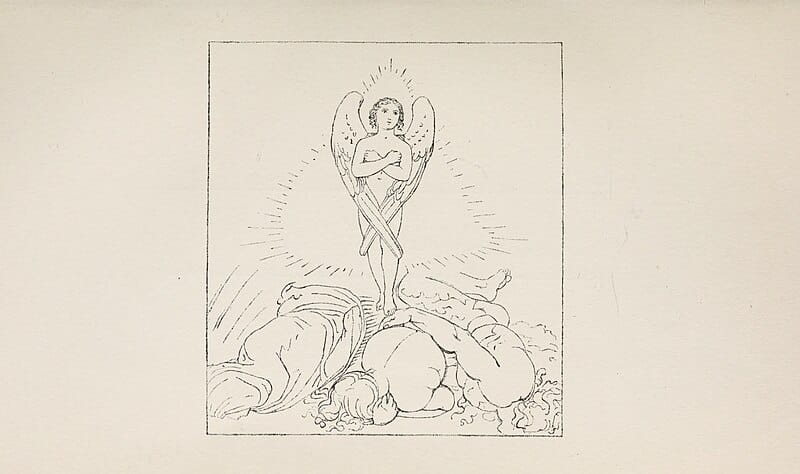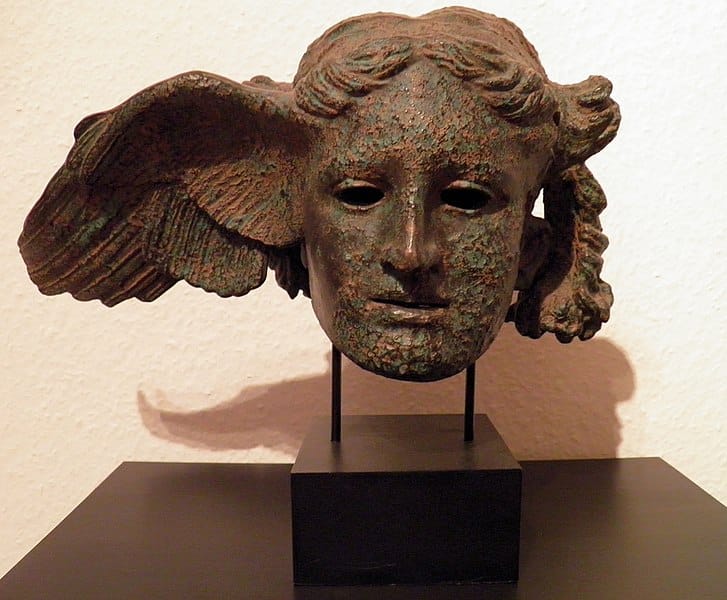Erebus, often forgotten amidst the pantheon of Greek gods, is a primordial deity representing darkness and shadow. This ancient god, born from Chaos, played a significant role in the creation myths of the Greeks, symbolizing the deep darkness that existed before the world as we know it came into being.
Erebus Key Facts
| Parents | Chaos |
| Partners | Nyx (Night) |
| All Siblings | Gaia, Tartarus, Nyx (possibly Eros, the Greek God of love) |
| Offspring | Aether (Brightness) and Hemera (Day) |
| Other names | – |
| Roman name | Erebus |
| The God of | Darkness and Shadow |
| Symbols | Shadows, the Deep Abyss |
Name and Etymology
The name “Erebus” is derived from an ancient Greek word which means “deep darkness” or “shadow”. This name perfectly encapsulates his essence, as he personifies the profound darkness that existed before the cosmos was formed. In Roman mythology, Erebus retains his Greek name, a testament to his fundamental nature that transcends cultural interpretations. While not as commonly referred to by epithets like other gods, Erebus’s very name evokes a sense of mystery and the unknown.

Erebus Origins
Erebus emerged from Chaos, the vast, gaping void that existed before the world was shaped. As one of the first primordial deities, he represents the deep darkness that blanketed the nascent universe. This darkness was not merely the absence of light but a tangible, enveloping force. Erebus’s role in Greek mythology is pivotal, for from his union with Nyx, the night, came other essential elements of the universe, such as Aether, the brightness, and Hemera, the day. Together, these entities began the process of shaping the world and bringing order to Chaos.
Erebus Relationship and Offspring
Erebus, as a primordial deity, has intricate relationships that are foundational to the Greek mythological cosmos. His union with Nyx and the subsequent offspring they produced are central to understanding the balance and interplay between light and darkness in the ancient Greek worldview.
Relationship with Nyx
Erebus’s most profound relationship was with Nyx, the personification of night. Both born from Chaos, they represented the earliest stages of the universe, a time when darkness was predominant. Their union is symbolic of the merging of deep darkness with the night. This relationship is not just a romantic or familial bond but a fundamental intertwining of two essential cosmic forces. Together, they set the stage for the emergence of light and day, creating a cyclical balance that the ancient Greeks observed in their daily lives.
Aether: The Divine Brightness
From the union of Erebus and Nyx came Aether, representing the divine brightness and upper air. Aether stands in stark contrast to his father’s domain of darkness. As the embodiment of the upper sky and the air that the gods breathed, Aether signifies the heavenly light, a beacon emerging from the depths of Erebus’s shadows. This juxtaposition between father and son emphasizes the duality and balance inherent in the universe: where there is darkness, light will eventually emerge.
Hemera: The Light of Day
Hemera, another offspring of Erebus and Nyx, personifies the day. Just as Aether contrasts Erebus, Hemera stands in opposition to her mother, Nyx’s realm of night. Every morning, Hemera disperses night’s mists, bringing light to the world, only to be enveloped by the night once again as the day ends. This cyclical dance between mother and daughter represents the eternal rhythm of day and night, a balance maintained in the cosmos. Hemera’s role underscores the transient nature of light in the face of the enduring, ancient darkness represented by Erebus.
Depiction And Characteristics
Erebus is often depicted as an intangible presence, a vast expanse of darkness. He doesn’t have a defined form like the anthropomorphic gods of Olympus. Instead, he embodies the very essence of shadow and the abyss. His personality is not detailed extensively in myths, but he represents the unknown, the mysteries hidden in the shadows, and the profound depths of the universe. As a primordial deity, his powers are vast, encompassing all that is dark and shadowy.
Erebus Roles And Responsibilities
As the god of darkness and shadow, Erebus’s primary role is to represent the deep darkness that existed before the cosmos. He stands as a reminder of the universe’s chaotic beginnings and the mysteries that lie in the uncharted depths. While not actively worshipped like the Olympian gods, Erebus’s presence is felt in the daily transition from day to night and the ever-present shadows that play upon the earth.
Games with Erebus
Test your knowledge about Erebus and other primordial gods of Ancient Greece with this fun quiz:
Don’t forget to try out our other games as well!
Myths about Erebus
Erebus, being a primordial deity, doesn’t feature prominently in many myths. However, his significance is felt in the creation stories. One of the most notable mentions is his union with Nyx, leading to the birth of Aether and Hemera. This union symbolizes the balance between light and dark, day and night, and the cyclical nature of the universe.
Erebus In Ancient Greek Religion
Erebus, while not a central figure of worship, was acknowledged in various rites and ceremonies. The Greeks recognized his importance in the grand tapestry of creation. There aren’t specific temples dedicated to Erebus, but his essence was invoked in rituals that delved into the mysteries of the universe and the unknown.
Representations Of Erebus In Art
Erebus’s abstract nature means he isn’t often depicted in ancient Greek art. However, when represented, he’s shown as a vast, shadowy expanse, sometimes intertwined with Nyx, symbolizing their close relationship and the balance between darkness and night.
Mentions in Ancient Texts
Erebus is mentioned in several ancient texts, emphasizing his role in the creation myths. Hesiod’s “Theogony“, written around 700 BC, details the birth of the primordial deities, including Erebus. In this work, Hesiod describes the emergence of Erebus from Chaos and his subsequent union with Nyx.
Another mention can be found in the Homeric hymns, where Erebus’s domain is described as the dark region beneath the earth, through which the souls of the dead pass.
Frequently Asked Questions
Erebus personifies the deep darkness and shadow that existed before the cosmos was formed.
Erebus emerged from Chaos, the primordial void.
Yes, from his union with Nyx, Erebus fathered Aether (Brightness) and Hemera (Day).
Erebus is often shown as a vast, shadowy expanse, representing his dominion over darkness.
In Roman mythology, Erebus retains his Greek name and similar attributes.
While not a central figure of worship, Erebus’s essence was acknowledged in various rites and ceremonies in ancient Greece.
Featured Image Credit: Carole Raddato, Public domain, via Wikimedia Commons

